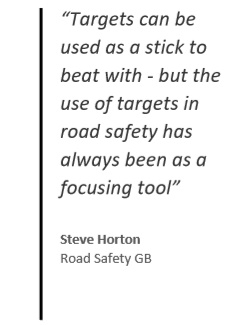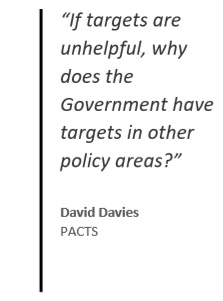
Steve Horton, Road Safety GB’s director of communications, has made an impassioned plea for Government to think again with regard to road safety targets.
Road Safety GB is also calling for road safety targets to be renamed ‘ambitions’ – because the phrase ‘demonstrates a clearer aspiration for the future’.

Steve Horton’s intervention comes in the wake of the parliamentary road safety debate on 5 November, during which the road safety minister Jesse Norman made it clear the Government is not minded to reintroduce targets.
Road Safety GB has aligned with PACTS in calling for a change of heart.
In a statement issued today (12 Nov), Steve Horton said: “The vast majority of personal injury crashes on our roads can and should be avoided, but for this to happen road users must accept the importance of safer behaviour – and national targets confirm this importance.
“Targets can be used as a stick to beat with – but the use of targets in road safety has always been as a focusing tool to ensure stakeholders, and more importantly decision makers and funders, remain committed to reducing the number of life changing events on our roads.
“Road safety professionals have always viewed targets as something not just to aim for – but to exceed.
“In fact, Road Safety GB would like them renamed as ‘ambitions’ – the word ‘target’ implies success or failure and relates to a nominal figure, whereas ‘ambitions’ demonstrates a clearer aspiration for the future.”
 Speaking to Road Safety News last week, David Davies, executive director of PACTS, said road safety targets are needed ‘to hold the Government to account’.
Speaking to Road Safety News last week, David Davies, executive director of PACTS, said road safety targets are needed ‘to hold the Government to account’.
David Davies said: “Targets would help to ensure that specific measures were selected on the basis of effectiveness and targeted at substantial casualty numbers, rather than measures which might simply be easy or popular.
“If targets are unhelpful, why does the Government have targets in other policy areas and set them for Highways England?”
Steve Horton went on to reiterate the important role targets can play in helping to protect funding for road safety.
He said: “What road safety professionals really need is a lead from Government to ensure casualty reduction stays high on the list of funding priorities, especially in times when local authorities are struggling to ensure road safety remains a key priority for local funding.
“Targets themselves will not reduce crashes on our roads, but they will demonstrate our commitment to reducing needless death and injury – and help road safety professionals ensure this remains a clear priority for resources and action.”
HAVE YOUR SAY
What’s your view? Should the Government reintroduce road safety targets to help drive down casualties? Register your view in our Twitter poll – or leave a comment below.
HAVE YOUR SAY 💬
Do you support the reintroduction of casualty reduction targets for the road safety sector?
Poll closes at 5pm (14 Nov) – please RT once voted!#RSGB
— Road Safety GB (@Road_Safety_GB) November 13, 2018
It’s one thing to politically talk the talk about road safety as talk is cheap but it a far different thing instigating interventions with the effect of making our roads safer. That costs in accountable terms, commitment terms and of monies.
It’s no use talking if they are not willing to put money where their mouth is.
Rhetoric costs nothing… except in this case…… Lives.
R.Craven
+1
Driving around each day, I regularly see accident-triggering behaviour by motorists, due to carelessness and recklessness. There seems to be a yawning chasm between the DFt notionally setting ‘targets’ to ‘show commitment’ and actually addressing and eliminating such behaviour on the ground, where it all happens. Rather than aim for targets, the authorities should be bringing thinking more about ‘targeting’ the ‘accident generators’.
Hugh Jones
--3
In 2015 government committed to undertaking a capacity review of road safety capability in Britain. In 2018 it published that review which contained the following statement:
“While a high-level commitment to road safety in key DfT lead agency units is evident, the absence of defined national road safety ambition in a measurable safety performance framework is setting back effort. There is general agreement that a more strategic focus on results (the prevention and reduction of deaths and serious injuries) is required and the evidence base for the efficacy of targets in reducing deaths and serious injuries is well established. The devolved administrations and many working at national and local levels want to see the re-establishment of a national road safety performance framework. A good practice Safe System performance framework comprises a long-term goal towards zero deaths and serious injuries, supported by interim quantitative targets to reduce death and serious injuries, which are in turn supported by a set of measurable safety performance objectives related to death and serious injury prevention and reduction. Examples of successful adoption of this framework can be found in Norway and Sweden which, despite the challenge for road safety presented by economic recovery following the global financial crisis in the last decade, maintain their global leadership in road safety with lower road fatality rates than achieved to date in Britain.”
In this specific respect the report made the following recommendations, amongst others:
“Underpin the government’s adoption of the Safe System approach with an agreed national road safety performance framework to form the core of a new British road safety strategy. This would provide the focus for all other institutional delivery functions. The national road safety performance framework would:
Set interim quantitative targets to 2030 to reduce the numbers of deaths and serious injuries; [and] Set measurable, intermediate outcome objectives for activities to 2030, for which there is a strong evidence base for a direct relationship to the prevention of death and serious injury and which are used by global road safety leaders.”
The full test is available at https://assets.publishing.service.gov.uk/government/uploads/system/uploads/attachment_data/file/717062/road-safety-management-capacity-review.pdf
It was a good idea to commission this review. It would be even better to follow through on its recommendations.
To respond to some of Hugh’s points: these recommendations come from a Vision Zero perspective so the end game is clearly defined. It’s also worth noting that arising from that Vision Zero perspective and Safe Systems methodology is a desire not to eliminate collisions per se but to eliminate KSI as an outcome. The 2010 targets were reached by several authorities in advance of the target date and those of us fortunate to be part of that group were invited to adopt additional ‘’stretched’’ targets – which many of us did, and many of those stretched targets were also achieved meaning relevance was never an issue. Achieving one ambitious target merely clears the decks ready for the next one.
Jeremy, Exeter
+1
How would the cut-off point for the target be determined? What sort of crashes are they out to prevent via these targets and which ones are excluded. Are they going to stop when a target has been reached or carry on, in which case the targets become irrelevant from that point on, although they do it would seem, have a PR purposes i.e. “Targets themselves will not reduce crashes on our roads, but they will demonstrate our commitment to reducing needless death and injury”
Hugh Jones
--1